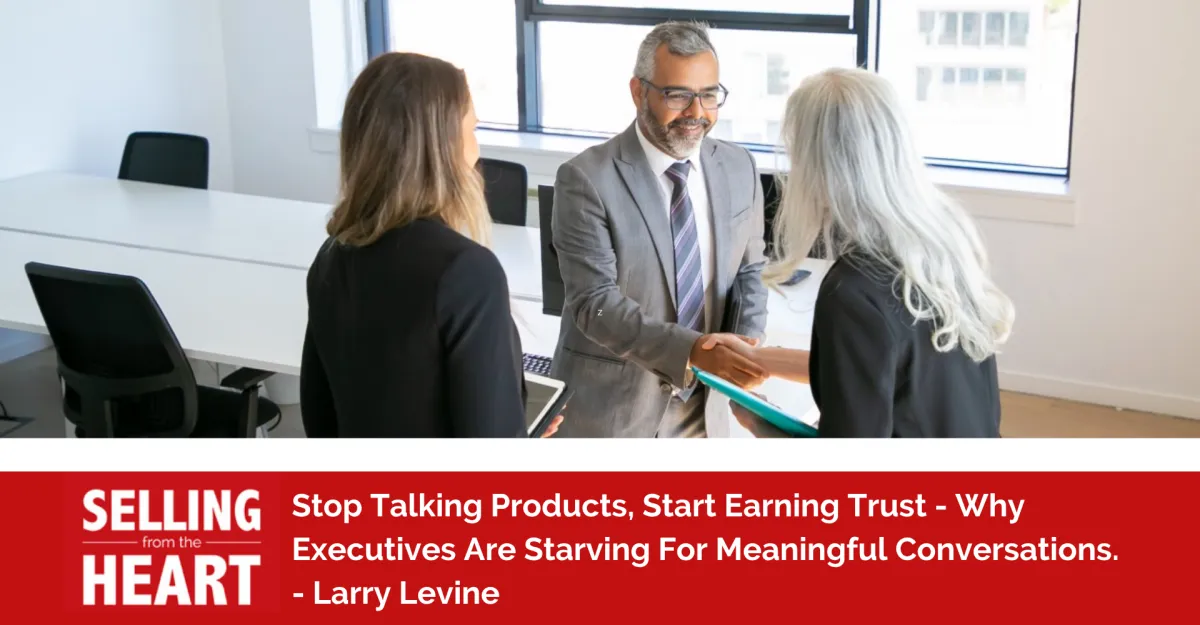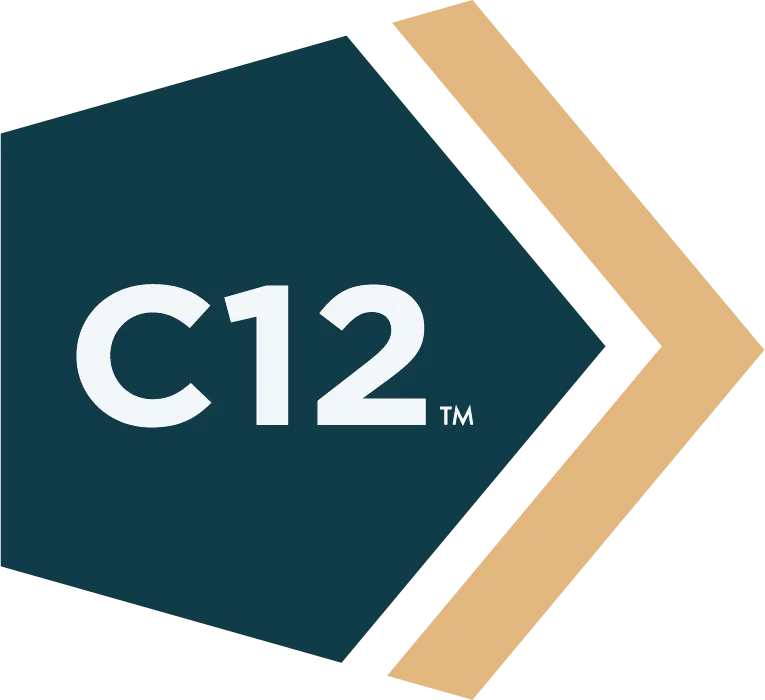The Selling From the Heart Blog

Stop Talking Products, Start Earning Trust - Why Executives Are Starving For Meaningful Conversations.
"Conversation isn't about proving a point; true conversation is about going on a journey with the people you are speaking with."
Ricky Maye
What kind of journey are you taking your clients or future clients on?
Is it a product centric, very transactional journey or is it business centric, a very transformational journey?
To some degree, traditional sales conversations often focus on persuasion, convincing the other people of your point, product, or solution.
When you start viewing conversation as a shared journey, this fundamentally changes the relational dynamic by:
Building trust. Effective sales conversations are deeply rooted in trust and comfort. Engaging in a genuine dialogue rather than a one-sided pitch, puts people at ease, creating the conditions for honest exchange and mutual understanding.
Active listening. Instead of pushing a predetermined agenda (your agenda), intentionally listen, seeking to understand their unique sets of challenges, needs, and aspirations. This approach uncovers deeper insights and allows you to tailor meaningful value authentically.
Co-creation of value. When embarking on a conversational journey, remember this all about collaboratively exploring solutions. The focus must shift from selling a product to solving a problem together.
Long-term relationships, not transactions. A journey-based conversation doesn't end when the meeting is over or when the deal is won. It lays the foundation for ongoing relationships, referrals, and repeat business, as everyone feels heard, respected, and valued.
Executives are hungry for insights that get them thinking, not sales scripts that clutter their inboxes.
Sales, let's just face it, it's hyper-competitive and noise filled. One truth has never been clearer, executives don’t want another pitch, they want perspective.
If you're still leading with product, speeds, and feeds, you're not just getting ignored, you’re losing credibility. Especially at the executive level, success is no longer about how innovative your solution is. It’s about how relevant, insightful, and trustworthy you are.
I'm calling out all salespeople and their leaders, stop selling and start having meaningful business conversations. That’s the key to gaining trust and building lasting credibility with executive decision-makers.
They want partners who understand the nuances of their business and can speak fluently about their industry’s challenges and opportunities.
As the late Harvard Business School professor Theodore Levitt once said, “People don’t want to buy a quarter-inch drill. They want a quarter-inch hole.” The implication? You must shift your focus from what you're selling to what your client is solving.
In a business world overflowing with options, relevance is the rarest and most valuable currency.
Why Product-Centric Conversations Fail With Executives
Executives Don't Buy Products, They Buy Outcomes
Executives sit at the top of an organization with one core responsibility, driving results.
Whether it’s increasing revenue, reducing cost, improving agility, or boosting innovation, their focus is strategic, not tactical.
A product-centric conversation, no matter how technically brilliant, anchors the conversation at the wrong level. It doesn’t speak their language. It dives too quickly into the how, bypassing the why that matters most to executives.
Instead of hearing, “Our solution integrates with X system and offers Y functionality…”
This is what they’re thinking:
“How does this help us grow faster?”
“Will this reduce risk or drive competitive advantage?”
“Can this scale with our strategy?”
“What measurable impact will this have on our KPIs?”
To resonate at the executive level, your conversations must be outcome-driven. Start by speaking their language, business impact. You must frame the discussion around what success looks like for their organization, not what your product does.
Connect your solution to the bigger picture, how it aligns with their goals, supports their priorities, and delivers quantifiable value. Only then does it earn you a seat at the executive table.
Features Don’t Build Trust, Understanding Does
Executives aren’t evaluating your pitch purely on technical merit. They’re evaluating you.
Are you someone who understands their business challenges? Do you have a point of view on their market? Can you offer insights that reframe how they see their problems?
If all you talk about is your product, the answer to all those questions is no.
Your technical solution may be impressive, but if you focus solely on product specs, you’re missing the bigger picture.
Features don’t answer critical executive questions such as:
“Do they understand what I’m actually trying to solve?”
“Can they help me see things I’m not seeing?”
“Will they be a strategic partner or just another vendor?”
Trust is built when you demonstrate empathy and insight.
This means doing the hard work by gaining an understanding of their industry trends, then coming to the table with perspectives that get them thinking or reveal hidden opportunities.
When you shift the conversation from "what our product does" to "here’s what we’re seeing in your market, and here’s how others are navigating similar challenges," you reframe your role.
Being Product-Led Makes You Replaceable
When your only differentiator is your product, you're just another vendor. And in the mind of a busy executive, vendors are easily swapped out or commoditized.
No matter how innovative your product is or how great you think it is, it has an expiration date on uniqueness. Features can be copied. Pricing models can be matched. Speed, convenience, and even quality, all of these can and will be commoditized over time.
The second someone sees you as “just a vendor,” you’ve entered the most dangerous territory in business, the replaceable zone.
In this zone, you’re evaluated, not engaged. You’re compared, not consulted. You’re priced, not valued.
And the problem isn’t your product, it’s how you’re showing up.
This is all about a shift in positioning, power, and purpose. When you lead with tailored insight and strategic questioning, you stop being a source of solutions and start being a source of clarity.
Executives don’t buy products. They buy confidence. They buy forward momentum. They buy people who see around corners.
When you show up with insight, you’re no longer part of the noise, as executives will make time for your voice.

Grab the books that will get you a seat at the business table
4 Pillars of Executive-Level Conversations
Research Ruthlessly
Preparation is your competitive edge. Executives expect you to walk into a conversation with a sharp understanding of:
Their industry dynamics
Their strategic priorities
Recent earnings or press releases
Market threats they’re facing
Relevant wins and losses
Your action tip - Use tools like LinkedIn, earnings calls, and industry analyst reports. Look at the CEO’s language, what are they emphasizing? Tailor your conversation accordingly.
Lead With Insight, Not Inquiry
The worst thing you can do in an executive meeting is ask: “So what keeps you up at night?”
Executives expect you to come in with a strong point of view.
You can say something such as, “Given your recent acquisition and push into new markets, I imagine aligning your operations and systems is top of mind. Here’s what we’ve seen work…”
This is a credible, insight-led conversation starter.
Your action tip - Build 3 insight statements before every meeting. These should reflect market trends, peer benchmarks, and business implications, not your product.
Translate Features into Business Leverage
You don’t have to abandon your product; you must translate it.
As examples:
“A finance director reduced reporting errors by 60% after we automated their reconciliation processes.”
“A healthcare provider saved 40 hours per week by removing manual steps from their patient intake system.”
Executives care about leverage, not functionality.
Your action tip - For every feature you highlight, write down three business implications. Then ask yourself, how does this help the executive move the needle?
End With Next-Level Thinking, Not Next Steps
Executives don’t want to be closed. They want intelligent and thought-provoking conversation. End the conversation by painting a picture of what’s possible.
You can say something such as, “Based on where your organization is headed, I think there’s an opportunity to not only streamline this process but to reframe how you think about your client experience entirely.”
Do you believe this invites future thinking and positions you as a strategic thinker? Of course it does.
Your action tip - Prepare one bold, forward-looking insight or question to wrap-up every executive meeting.
Credibility Is the Currency of Trust
Executives get endless requests. Stand out by delivering immediate value.
Here's how you can make it happen:
Be direct, skip the jargon and fluff. Speak clearly to their goals.
Use peer proof. Executives trust peers, not broad claims.
Speak their language. Use their terms and metrics. Align with their mindset.
Ask smart questions. Show you think like a leader.
Think business first, not product. That’s how you earn trust.
Trust Isn’t Given. It’s Earned, Preferably Without a 45-Minute Slide Deck.
Executives aren’t dreaming of more vendor meetings. They’re dreaming of Wi-Fi outages during vendor meetings.
Executives aren’t dying for another vendor to “circle back” and “touch base” with “a few quick slides.” They’ve seen enough pitches to power a small film festival.
They don’t want buzzwords, feature dumps, or someone saying “synergy” with a straight face.
They want someone who actually gets their world and ideally doesn’t open with, “Let me tell you about our award-winning solution.”
If you want a seat at the table, don’t show up like a sales robot. Show up like someone who’s had a thought in the last 24 hours.
Here’s the deal, it’s not your product that wins hearts and minds. It’s your ability to talk like a grown-up about what actually matters.
People buy from those who make them feel understood, not those who make them wish for a fire drill.
So, if you want to be remembered, respected, and invited back?
Ditch the pitch. Bring insight. And maybe just maybe don’t say “low-hanging fruit” unless you're actually handing them a banana.
Originally published on Larry Levine's LinkedIn.




